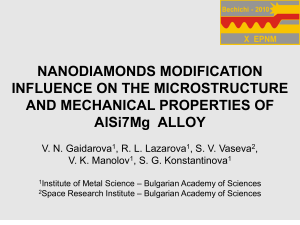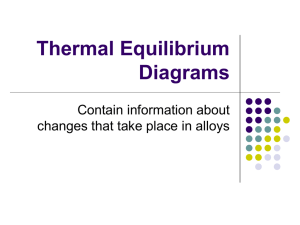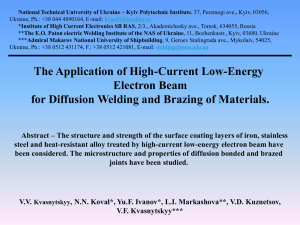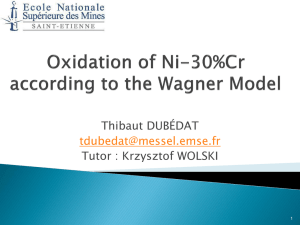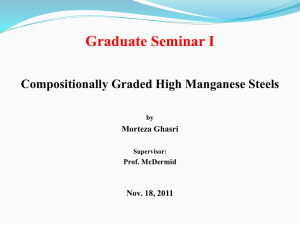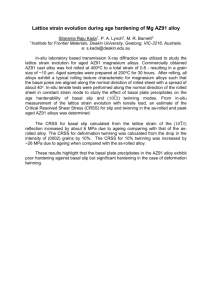Microstructure and Mechanical Properties of Ductile Aluminium Alloy
advertisement
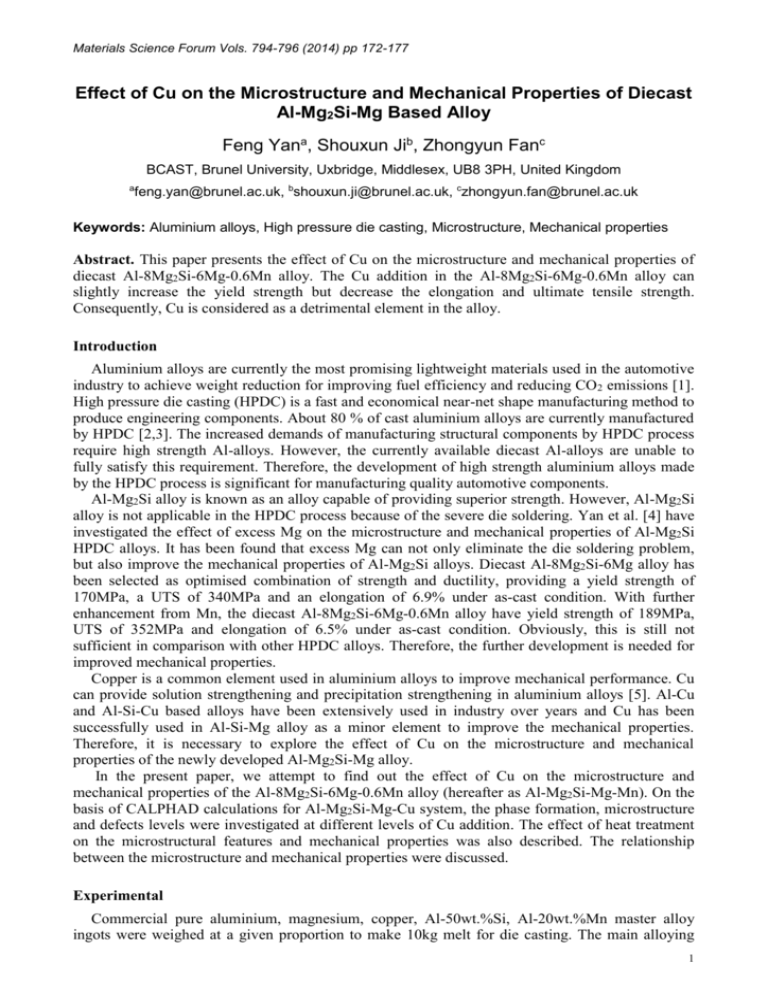
Materials Science Forum Vols. 794-796 (2014) pp 172-177 Effect of Cu on the Microstructure and Mechanical Properties of Diecast Al-Mg2Si-Mg Based Alloy Feng Yana, Shouxun Jib, Zhongyun Fanc BCAST, Brunel University, Uxbridge, Middlesex, UB8 3PH, United Kingdom a feng.yan@brunel.ac.uk, bshouxun.ji@brunel.ac.uk, czhongyun.fan@brunel.ac.uk Keywords: Aluminium alloys, High pressure die casting, Microstructure, Mechanical properties Abstract. This paper presents the effect of Cu on the microstructure and mechanical properties of diecast Al-8Mg2Si-6Mg-0.6Mn alloy. The Cu addition in the Al-8Mg2Si-6Mg-0.6Mn alloy can slightly increase the yield strength but decrease the elongation and ultimate tensile strength. Consequently, Cu is considered as a detrimental element in the alloy. Introduction Aluminium alloys are currently the most promising lightweight materials used in the automotive industry to achieve weight reduction for improving fuel efficiency and reducing CO 2 emissions [1]. High pressure die casting (HPDC) is a fast and economical near-net shape manufacturing method to produce engineering components. About 80 % of cast aluminium alloys are currently manufactured by HPDC [2,3]. The increased demands of manufacturing structural components by HPDC process require high strength Al-alloys. However, the currently available diecast Al-alloys are unable to fully satisfy this requirement. Therefore, the development of high strength aluminium alloys made by the HPDC process is significant for manufacturing quality automotive components. Al-Mg2Si alloy is known as an alloy capable of providing superior strength. However, Al-Mg2Si alloy is not applicable in the HPDC process because of the severe die soldering. Yan et al. [4] have investigated the effect of excess Mg on the microstructure and mechanical properties of Al-Mg2Si HPDC alloys. It has been found that excess Mg can not only eliminate the die soldering problem, but also improve the mechanical properties of Al-Mg2Si alloys. Diecast Al-8Mg2Si-6Mg alloy has been selected as optimised combination of strength and ductility, providing a yield strength of 170MPa, a UTS of 340MPa and an elongation of 6.9% under as-cast condition. With further enhancement from Mn, the diecast Al-8Mg2Si-6Mg-0.6Mn alloy have yield strength of 189MPa, UTS of 352MPa and elongation of 6.5% under as-cast condition. Obviously, this is still not sufficient in comparison with other HPDC alloys. Therefore, the further development is needed for improved mechanical properties. Copper is a common element used in aluminium alloys to improve mechanical performance. Cu can provide solution strengthening and precipitation strengthening in aluminium alloys [5]. Al-Cu and Al-Si-Cu based alloys have been extensively used in industry over years and Cu has been successfully used in Al-Si-Mg alloy as a minor element to improve the mechanical properties. Therefore, it is necessary to explore the effect of Cu on the microstructure and mechanical properties of the newly developed Al-Mg2Si-Mg alloy. In the present paper, we attempt to find out the effect of Cu on the microstructure and mechanical properties of the Al-8Mg2Si-6Mg-0.6Mn alloy (hereafter as Al-Mg2Si-Mg-Mn). On the basis of CALPHAD calculations for Al-Mg2Si-Mg-Cu system, the phase formation, microstructure and defects levels were investigated at different levels of Cu addition. The effect of heat treatment on the microstructural features and mechanical properties was also described. The relationship between the microstructure and mechanical properties were discussed. Experimental Commercial pure aluminium, magnesium, copper, Al-50wt.%Si, Al-20wt.%Mn master alloy ingots were weighed at a given proportion to make 10kg melt for die casting. The main alloying 1 Materials Science Forum Vols. 794-796 (2014) pp 172-177 elements Al, Si, Cu and Mn were melted and held at 750 °C for 30 min before adding Mg ingot which had been preheated to 200 °C. For all the experiments, the melts were degassed using N 2 before composition analysis. The composition of each alloy was measured with an optical mass spectrometer on a cross section of a 40mm cylindrical casting. At least five spark analyses were performed and the average was taken as the chemical composition of the alloy. The measured alloys contain 7.65Mg2Si, 5.9Mg, 0.55Mn, 0.1Fe with 0.31, 0.52, 0.73 and 0.92Cu in wt.%, respectively. Six ASTM standard tensile samples that include three 6.35 mm round sample and three square samples were cast in each shot using a 4500kN cold chamber HPDC machine. The pouring temperature of the melt was measured by a K-type thermocouple, usually at 50°C above the calculated liquidus temperature. All the castings were left in ambient atmosphere for at least 24 hours before testing the mechanical properties. The microstructure was examined using a Zeiss SUPRA 35VP scanning electron microscope (SEM), equipped with EDX. The quantitative EDX analysis in SEM was performed at an accelerating voltage of 20 kV on the sample. In situ spectroscopy calibration was performed in each session of the EDX quantification using pure copper. Results In order to understand the effect of Cu addition on the phase formation in the Al-Mg2Si-Mg-Mn alloy, a cross section of equilibrium phase diagram was calculated with different levels of Cu addition and the result is shown in Fig. 1. It is seen that the Al15(Fe,Mn)3Si2 intermetallic phase is the prior phase during solidification, which is followed by the formation of α-Al phase and eutectic phase. When Cu is below 1.5wt.%, the addition of Cu does not change the liquidus temperature, but decrease the solidus temperature of the Al-Mg2Si-Mg-Mn alloy. The quaternary eutectic reaction occurs at 1.24wt.%Cu, during which the S (AlMgCu) phase precipitates with the Al15(Fe,Mn)3Si2 intermetallic phase and Al+Mg2Si phase. More importantly, the alloy solidification range was increased with the rise of Cu content. Without Cu in the alloy, its solidification range is 83°C. When 1wt.%Cu is added, the solidification range increases to 127°C. As Cu effectively increases the solidification range, it may not be beneficial for the castability. Fig. 1 Cross section of the equilibrium phase diagram of Al-8Mg2Si-6Mg-0.6Mn alloy with different Cu content. Fig. 2 shows the as-cast microstructure of Al-Mg2Si-Mg-Mn alloys without and with 0.5Cu. It is seen the microstructure of the alloy without Cu consisted of primary α-Al, Al-Mg2Si eutectics, βAl3Mg2 phase and α-AlFeMnSi phase. When adding 0.5Cu into the alloy, a number of Cu-rich intermetallics were presented as irregular morphology in the microstructure. The volume fraction of 2 Materials Science Forum Vols. 794-796 (2014) pp 172-177 the Cu-rich phase increased with the increase of Cu content, as shown in Fig. 3. The increase was from 2.1% to 7.8% when Cu was added from 0.31 to 0.92wt.%. In the meantime, the increased porosity was observed in the alloy with higher Cu content. As shown in Fig. 4, the porosity level was doubled when Cu was increased from 0.31 to 0.92wt.%. The morphology of the porosity can be seen in Fig. 5. The randomly distributed porosity spread over all the section of casting. The porosities exhibited irregular morphologies and were located between eutectic phases. This indicates that most of these porosities showed the feature of shrinkage porosity. (a) (b) Al3Mg2 Mg2Si Al13Mg5Cu α-AlFeMnSi α-Al Fig 2 Backscattered SEM micrographs showing the microstructure of (a) Al-8Mg2Si-6Mg-0.6Mn and (b) Al-8Mg2Si-6Mg-0.6Mn-0.5Cu alloys. 3.0 Porostiy fraction(%) Solid fraction (%) 10.0 8.0 6.0 4.0 2.0 1.0 2.0 0.0 0.0 0.2 0.4 0.6 0.8 1 Cu (wt.%) Fig. 3 The effect of Cu on the solid fraction of Cu-rich intermetallics in Al-8Mg2Si-6Mg0.6Mn alloy. 0.2 0.4 0.6 Cu (wt.%) 0.8 1 Fig 4 The effect of Cu content on the porosity levels in Al-8Mg2Si-6Mg-0.6Mn alloy. SEM/EDX quantification confirmed the Cu-rich intermetallics consisted of Al, Cu and Mg. The average compositions of Cu-rich intermetallics are shown in Table 1 for the Al-Mg2Si-Mg-Mn alloy with different Cu content. The Cu-rich compounds could be described as Al13Mg5Cu in the experimental alloys, although slightly different formula was seen in Table 1. The results in Figs.2&5 indicate that Cu-rich intermetallic phase is a primary phase, rather than a eutectic phase. The effect of Cu content on the mechanical properties of the Al-Mg2Si-Mg-Mn alloy with Cu addition under as-cast condition is shown in Fig. 6. By varying the Cu content from 0.31 to 0.92wt.%, the yield strength was increased from 193MPa to 207MPa, indicating an increase of 7.3%. However, the ultimate tensile strength (UTS) and elongation were decreased with the 3 Materials Science Forum Vols. 794-796 (2014) pp 172-177 increase of Cu content. When Cu was at 0.31wt.%, the alloy had a UTS of 343MPa, but it became 311MPa when Cu was at 0.92 wt. %, corresponding a decrease of 9.3%. Meanwhile, the elongation was decreased from 4.8% to 3.5% in the same range of Cu content, which represents the decrease of 27%. (a) (b) Fig 5 Backscattered SEM micrographs showing (a) the distribution of porosity and (b) the morphology of porosity in the Al-8Mg2Si-6Mg-0.6Mn-0.5Cu alloy. Table 1 Average composition of Cu-rich intermetallic phase measured by quantitative SEM/EDX. Alloy with wt. %Cu 0.31 0.52 0.73 0.92 Identified compounds Al13Mg5Cu0.5 Al13Mg5Cu0.8 Al13Mg5Cu0.8 Al10Mg4Cu0.92 Al (at.%) 71.22 70.99 69.32 67.56 Mg (at.%) 26.14 24.98 26.66 26.65 400 Cu (at.%) 2.64 4.03 4.02 5.79 8.0 350 300 250 4.0 200 Elongation (%) Strength (MPa) 6.0 2.0 150 YS UTS El 100 0.0 0 0.2 0.4 0.6 0.8 1 Cu (wt.%) Fig. 6 Effect of Cu content on the mechanical properties of the Al-8Mg2Si-6Mg-0.6Mn-xCu alloy under as-cast condition. Fig. 7 shows the microstructure before and after solution heat treatment of Al-Mg2Si-Mg-Mn alloy with 0.7Cu. It is seen a significant reduction in the size and/or complete disappearance of the Cu-rich intermetallics in the alloy after solution heat treatment. This indicates that the majority of 4 Materials Science Forum Vols. 794-796 (2014) pp 172-177 the Cu-rich intermetallic phase was dissolved into the matrix. However, the laminar eutectic Mg2Si phase was slightly spheroidised. No obvious changes were observed in the solution treated samples. (a) (b) Fig. 7 Backscattered SEM micrographs showing the microstructure of Al-8Mg2Si-6Mg-0.6Mn0.7Cu alloy (a) under as-cast condition and (b) under solution heat treated condition at 490 °C for 15 mins. (a) (b) Fig. 8 TEM micrographs showing the precipitation of Cu-rich phase in the solution-treated Al8Mg2Si-6Mg-0.6Mn-xCu alloy after ageing at 180oC for 90 mins (a) without Cu addition (b) with 0.9wt.%Cu. 500 15.0 YS UTS El Strength (MPa) 9.0 300 6.0 200 Elongation (%) 12.0 400 3.0 100 0.0 0 0.2 0.4 0.6 Cu (wt.%) 0.8 1 Fig. 9 The mechanical properties of diecast Al-8Mg2Si-6Mg-0.6Mn-xCu alloy after solution treated at 490oC for 15 mins and aged at 180oC for 90 mins. 5 Materials Science Forum Vols. 794-796 (2014) pp 172-177 Fig. 8 shows the precipitation of Cu-rich phase in the Al-8Mg2Si-6Mg-0.6Mn alloy without Cu addition and with 0.9wt.% Cu. It is seen the obvious precipitation occurred in the Al grains after ageing heat treatment. The EDX quantitative analysis confirmed the precipitates had the same composition of Al13Mg5Cu, which has been detected in the as-cast alloy. Fig. 9 shows the mechanical properties of the Al-Mg2Si-Mg-Mn alloy with different Cu content. The alloy was solution treated at 490oC for 15mins and subsequently aged at 180oC for 90 mins. It is seen a significant increase of the yield strength, a decrease of elongation and essentially no change for the UTS. The yield strength was increased from 189MPa to 220MPa when Cu was increased from 0 to 0.92wt.%. The tensile strength was maintained at 380MPa, but the elongation was decreased from 9% to 7% in the same range of Cu content. Discussion Copper can provide a maximal strengthening and the substantial ductility can be retained when the Cu is dissolved into the aluminium matrix. Conversely, when the Cu phase is presented as a continuous network at grain boundaries, limited strength enhancement can be achieved with a severe reduction of the ductility [6]. In the as-cast Al-Mg2Si-Mg-Mn alloy, the majority of Cu-rich intermetallics are found along the grain boundary and sharp irregular shapes. Therefore, Cu-rich intermetallics have a limited enhancement on the strength but can significantly decrease the ductility. Moreover, Cu increases the solidification range, which promotes the formation of solid skeleton at a lower fraction and causes the difficult of liquid fill into the blocked area. This will result in the formation of hot-tearing in the as-cast microstructure, which can act as a crack initiator [7]. Therefore, the addition of Cu is detrimental for the mechanical properties. However, the Curich intermetallics can be dissolved into the matrix and precipitated during ageing. This can improve the strengthening in the alloy. Therefore, the yield strength can be increased after heat treatment. The unchanged UTS can be attributed to the balance of the increased yield strength and the simultaneously reduced elongation. Conclusion In the experimental range, the addition of Cu into the Al-8Mg2Si-6Mg-0.6Mn alloy can slightly increase yield strength but decrease ultimate tensile strength and elongation. Consequently Cu is considered as a detrimental element in the alloy. The quick T6 heat treatment can dissolve the majority of Cu-rich intermetallics during solution treatment, which are subsequently precipitated in the aluminium grains during ageing. Therefore after the quick T6 treatment, the yield strength is increased and the elongation is decreased while the UTS is maintained unchanged for the alloy with increased Cu content. References [1] A.I. Taub, P.E. Krajewski, A.A. Luo, J.N. Owens, JOM 2 (2007) 48-57. [2] S. Ji, D. Watson, Z. Fan, M. White, Mater. Sci. & Eng. A 556 (2012) 824–833. [3] S. Ji, Y. Wang, D. Watson, Z. Fan, Metall. Mater. Trans. A 44A (2013) 3185-3197. [4] F. Yan, S. Ji, Z. Fan. Materials Science Forum 765 (2013) 64-68. [5] I.J. Polmear, Light alloys from traditional alloys to nanocrystals, 2006, Elsevier/ButterworthHeinemann: Amsterdam; Boston. [6] L. F. Mondolfo, Aluminum alloys: Structure and Properties, 1976, London: Butterworths. [7] D.G. Eskin, Suyitno, L. Katgerman, Progress in Materials Science 49 (2004) 629-711. 6


